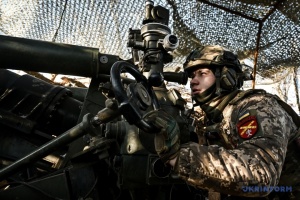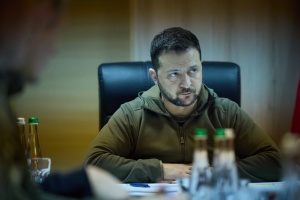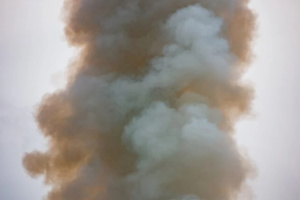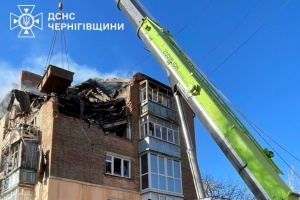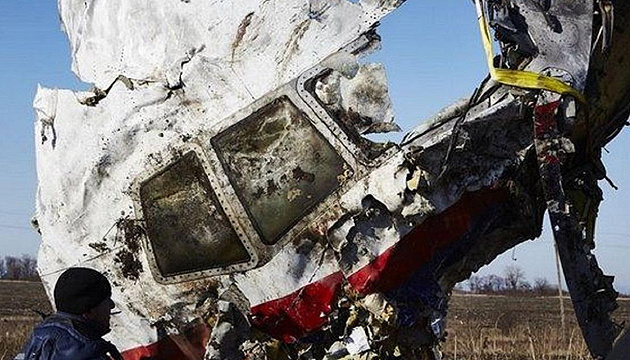
From MH17 to Kakhovka HPP. How Russia is trying to hide its crimes behind fakes
Each time, the Kremlin chose a strategy of ignoring the facts and shifting responsibility to Ukraine and the “collective West,” spreading a large number of “alternative versions” in the information field: from relatively plausible to frankly absurd.
The Center for Strategic Communication recalls the most large-scale Russian disinformation campaigns and explains why propagandists produce fake news.
Downing of MH17
On July 17, 2014, a passenger Boeing 777 of Malaysian Airlines was shot down in the sky over Donetsk region. The MH17 disaster was the deadliest since the September 11, 2001, terrorist attacks in the United States. The deaths of 15 crew members and 283 passengers, including 80 children, being citizens of the Netherlands, Malaysia, Australia, Indonesia, the United Kingdom, and other countries, shook the world. It became a matter of honour for Ukraine and the states that lost their citizens to establish all the circumstances of the event and bring the perpetrators to justice.
Independent investigators quickly established that the missile was fired by the Buk M-1 anti-aircraft missile system, which belonged to the 53rd Guards Anti-Aircraft Missile Brigade of the Russian Armed Forces and arrived in the occupied territory of Ukraine from Russia. The propagandists apparently set themselves the task of drowning reliable information in a sea of fakes. Almost simultaneously, “news” was spread in the information space about:
“Spanish dispatcher Carlos,” who allegedly saw Ukrainian combat aircraft on the radar in Boryspil;
transfer of Ukrainian Buk air defence systems to the ATO zone;
detonation of a mined aircraft in the air.
The first two “versions” were already distributed on July 17 by Russian media, with federal channels inclusive. Both were announced at a briefing of the Ministry of Defence of Russia on July 21.
Putin personally spoke about the “Spanish dispatcher” in an interview with American film director Oliver Stone in 2015.
Gradually, new “details” appeared. The Russian Ministry of Defence found the “American trace,” mentioning some kind of “experimental spacecraft to track the launches of missiles of various ranges,” which flew over the territory of Ukraine on the day of the disaster. There were no direct accusations against the United States at that time, but it gave rise to the development of a conspiracy theory about the alleged involvement of the United States in the downing of the airliner. It was the basis for the plot of the feature film War Correspondent, which premiered on NTV in December 2014.
Retired FSB officer Igor Girkin, who then held the “post” of “Minister of Defence” of the “DPR,” made a statement on July 18 about “old corpses” at the crash site. He thus created the basis for another conspiracy theory: staging a plane crash in order to harm Russia.
The “version” about the “Ukrainian attack aircraft/fighter” also had several variations. The Russian Ministry of Defence mentioned the Su-25 aircraft, the media — the Su-27 aircraft as well. Propagandist Mikhail Leontiev on the air of the Channel One showed a “sensational satellite image” with the image of the “Ukrainian MiG-29.”
In December 2014, the federal media even named the pilot — Major Vladyslav Voloshyn was the scapegoat.
The state corporation Almaz-Antey was responsible for promoting the version of the “Ukrainian Buk” and generating the relevant news plots. Its representatives made statements and presented the results of experiments, according to which the Boeing was allegedly hit not by the munition that was in service only in Russia, but by one that Ukraine had.
To enhance the credibility of such statements, Russian propagandists worked not only on new “versions,” but also spread fake “messages of the Western media,” which allegedly recognized Ukraine’s responsibility for the shooting down of the passenger plane.
The only version, in addition to the abstract “desire to harm Russia,” which the propagandists managed to produce, was an attempt on Putin’s life. Allegedly, the Russian aircraft No.1 on the day of the crash was in the same echelon as the Malaysian Boeing.
These fakes were promptly refuted: the Russians themselves ridiculed the bad-quality photo with the “Ukrainian attack aircraft,” while “dispatcher Carlos” turned out to be a previously convicted Spanish fraud who had never been to Ukraine.
🚨🚨 Remember "Carlos The Spanish Air-Traffic Controller" of #MH17 infamy, who was even cited by Putin in blaming Ukraine for downing the plane? Welp, turns out Jose Carlos Barrios Sanchez is an ex-con accused of fraud. @CarlSchreck & @RFERL track him down https://t.co/FoxkbV6d4N pic.twitter.com/QxsBjW3zko
— Christopher Miller (@ChristopherJM) March 14, 2018
The type of ammunition for the Buk missile system, which is only in service in Russia, was established by the investigation. The route of Putin’s plane ran 1,000 km from the place of the Boeing shoot-down. However, the persistence and intensity of Russian propaganda did its job: it managed to convince Russians that Ukraine shot down the plane, reach the hearts of conspiracy theorists around the world, and at least confuse those who did not follow the situation very closely.
The Bucha massacre
At the end of February 2022, Russian units that entered the territory of Ukraine from Belarus seized the city of Bucha in Kyiv region. For more than a month, the city was under occupation, accompanied by looting, kidnapping, torture, rape, and murder. After the retreat of the Russians, the world saw a terrible picture: the occupiers left the bodies of the killed Ukrainians right on the streets. According to the Office of the Prosecutor General of Ukraine, more than 1,700 civilians were killed in the Bucha district, about 700 of them — in Bucha.
In April 2022, footage from Bucha hit the front pages of world publications, leading TV channels filmed stories in the liberated city. It was repeatedly visited by foreign politicians and representatives of international justice.
The Kremlin propaganda reacted to the exposure of the crimes of the Russian army with a new wave of fakes and conspiracy. Not only Internet trolls and federal media, but also senior officials of the regime, joined their distribution. In particular, Russian Foreign Minister Sergei Lavrov stated that the massacre in Bucha occurred after Russian troops retreated. Belarusian dictator Alexander Lukashenko called the massacre “a special operation of the British.”
The most popular manipulations were speculations on the topic of bodies on the streets of Bucha and the time of their detection. Two narratives developed in parallel in the information space:
there were no mass murders in Bucha, it was all staged;
the murders were committed not by Russians, but by Ukrainians and (or) Western special services.
As part of the first narrative, fakes were spread about actors who “portrayed the dead,” as well as about the fact that the bodies were allegedly brought to Bucha specifically to create a “picture.”
The second narrative included reports about the “cleansing” of Bucha from pro-Russian residents by the Armed Forces of Ukraine or Azov soldiers, statements that civilians died not from Russian bullets, but from Ukrainian artillery during the battles for the city, etc.
As evidence of the “version” of the “performance with actors,” a video of extremely poor quality was used; when viewed, it could seem that the dead were moving.
Propagandists and conspiracy theorists used this “argument” even after the same video with a lower level of compression appeared on the network.
Getting fed up of this “it’s a moving arm” bullsh….. it’s a raindrop on the windscreen, alongside an inverted channel version for more clarity. The whole arm moving thing is just ridiculous. pic.twitter.com/ZiuEX4rFWc
— Aurora Intel (@AuroraIntel) April 3, 2022
It became obvious that the optical illusion is due to the dirty car window, the footage being shot from the inside of the vehicle, and the change of angle in the rear-view mirror during the movement of the car.
The groundlessness of speculation about the time of death of people was proved by satellite images of Bucha taken when the Russians controlled the city.
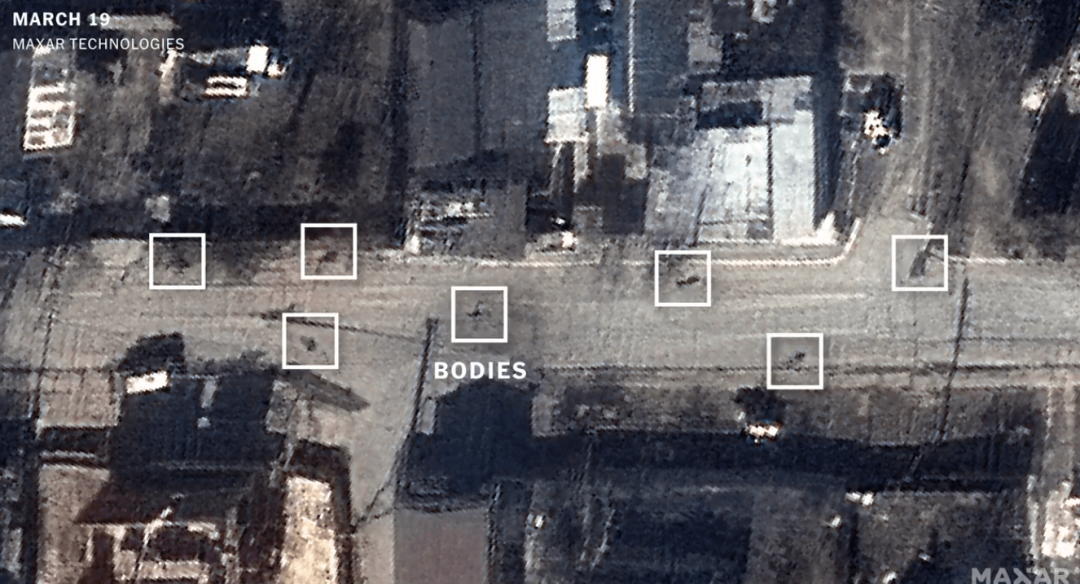
MAXAR / NYT / BBC
The results of forensic examinations and investigations made it possible to establish the causes and circumstances of the death of most of the victims: they were killed with small arms during the occupation.
Murder of POWs in Olenivka
After the Azovstal garrison stopped resistance on May 16, 2022, the Russians sent 211 Mariupol defenders to the prison located on the territory of the correctional facility in Olenivka, Donetsk region. The occupiers announced the preparation for a demonstration trial of the Azov soldiers and intensified the hysteria about the “crimes of the Nazis against the people of the Donbas.” On the night of July 28-29, an explosion occurred on the territory of the prison, which claimed the lives of at least 53 Ukrainian servicemen. 130 were wounded.
The Russian Ministry of Defence immediately accused the Armed Forces of Ukraine of shelling the correctional facility. State propaganda began to promote conspiracy theories about Ukraine’s motives and fake news about the use of American weapons to shell the prison. At the same time, the audience continued to be convinced that the Azov soldiers “deserve to die.” On April 30, a verified account of the Russian Embassy in the UK published a tweet calling for the prisoners to be hanged.
Ria Novosti published photos of the wreckage of HIMARS munitions. But the Russians did not provide any evidence that it was found in Olenivka.
The published photos from the explosion site clearly showed fire damage not characteristic of HIMARS. Questions also arose as to why only one building on the territory of the industrial zone was damaged, where all Azov prisoners had been transferred two days before the explosion. According to the Main Directorate of Intelligence of the Ministry of Defence of Ukraine, militants of the Wagner PMC staged a massacre to hide evidence of torture and embezzlement of funds allocated for the maintenance of prisoners. The Security Service of Ukraine published the interception of mercenaries’ conversations. It said that the Russians had placed the Grad MLRS system near the prison and used it to shell the positions of the AFU, but the latter did not strike back. The militants suggested that the explosion of the barrack could have been arranged from inside the building.
On July 30, Russian media spread a fake that the Pentagon allegedly “recognized” the AFU strike on Olenivka and called it “unintentional.”
In fact, a US defense official said the exact opposite, and this is recorded in the transcript of the briefing. “What would also not surprise me is if the Russians would — would lead us astray, in terms of information, and tell us that the Ukrainians had done this,” the Pentagon spokesman said.
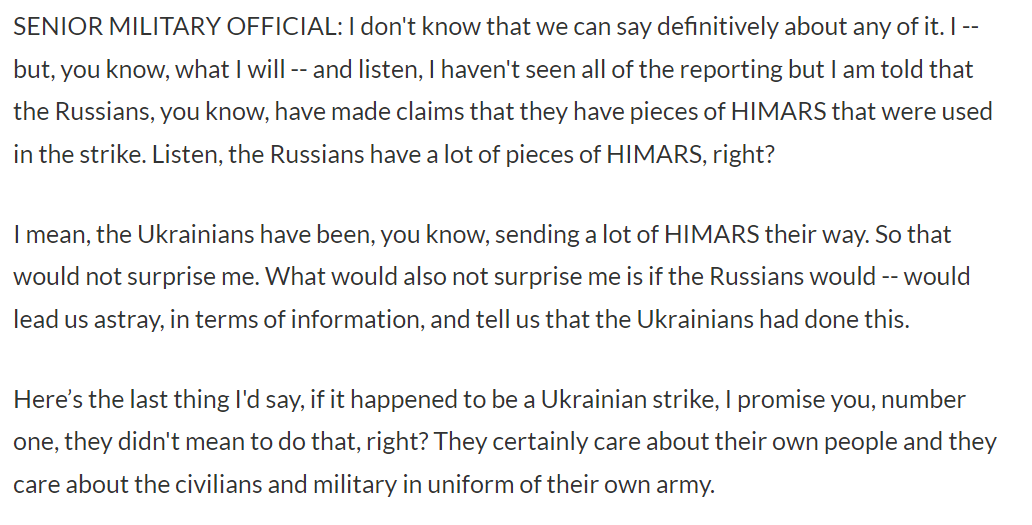
Russia blocked the possibility of a proper investigation into the circumstances of the deaths, refusing to provide the UN commission, established for this purpose, with security guarantees and access to the explosion site.
A year after the tragedy, on July 25, 2023, Volker Türk, the UN High Commissioner for Human Rights, verified that Russian statements turned out to be untrue.
“While the precise circumstances of the incident on the night of 28-29 July 2022 remain unclear, the information available and our analysis enable the Office to conclude that it was not caused by a HIMARS rocket,” the Commissioner said.

Blowing up of Kakhovka HPP
Explosions that occurred on the night of June 6, 2023, destroyed the Kakhovka hydroelectric power plant in Kherson region. Dozens of settlements, including Kherson, were in the flooded area. According to the Ministry of Internal Affairs of Ukraine, at least 31 civilians died. The number of deaths in the occupied territories has not been established. The scale of the damage caused to the environment makes it possible to qualify this crime as an act of ecocide.
Ukrainian intelligence and military-political leadership repeatedly reported to the world that the Russians had mined the hydroelectric power plant, and the Kremlin media periodically threatened to blow up the Kakhovka and other hydroelectric power plants in Ukraine. Despite this, Moscow’s efforts on the eve and after June 6 were aimed at shifting responsibility to Ukraine.
The messages spread contradicted each other again. Within hours, officials of the occupation administrations and propaganda media moved from denying the fact of the explosion to blaming the Armed Forces of Ukraine for the attack on the HPP. Putin’s spokesman Peskov also voiced these accusations.
There were confident statements about a missile strike, the use of multiple launch rocket systems, the consequences of last year’s shelling by HIMARS, and the deliberate raising of the water level by the Ukrainians for additional pressure on the dam.
But unlike other crimes, this time, the propaganda focused not on the “technical” part, but on the explanations why the destruction of the HPP was “beneficial to Ukraine” and “definitely not beneficial to Russia.”
War correspondents, Z-bloggers, anonymous Telegram channels explained the reasons for the “Ukrainian attack”:
distracting attention from the lack of success at the front (variation: due to the failure of the counteroffensive);
an attempt to destroy Russian fortifications and minefields on the eve of the counterattack;
an attempt to create problems with water, provoke a food crisis and environmental catastrophe in the occupied territories, in particular in Crimea; and
an attempt to garner stronger support of the West by accusing Russia of environmental crimes.
Propaganda deliberately ignored the fact that the flooding of a huge territory made it impossible for the AFU to take offensive actions on that part of the front, ignored the damage caused to the environment, the agricultural sector, and the export potential of Ukraine. Instead, a statement was promoted that the Kakhovka HPP became a “new Bucha” — a staging with the aim of harming Russia.
The vague position of the leading foreign media, which in the early days did not point to the obvious culprit of the disaster and limited themselves to the phrasing “the parties blame each other,” can be considered the result of the media activity of the Russians. The harsh reaction of the Ministry of Foreign Affairs of Ukraine and the public statement of historian Timothy Snyder once again have reminded the global journalistic community that it is impossible to equate facts and statements of a state that regularly lies.
Why is Russia lying so much?
At first glance, it would seem logical if Russian propaganda chose one “official version” and promoted it. Instead, it works out several alternatives, creates artificial newsbreaks, generates fakes, provides platforms for universal “experts,” and uses other methods of creating white noise. So, the Kremlin propaganda is not just trying to convince the world of its own “version” or “versions” of events. The following tasks are solved with the help of “alternative facts” and pseudoanalytics:
maximum disorientation of the audience through information overload;
devaluation of obvious facts by equating them with fakes, manipulations, and speculation;
promoting conspiracy thinking and undermining the trust of foreign citizens in their governments and high-quality media that “conceal the truth”; and
demotivating the audience, promoting the narrative “we will never know the whole truth.”
The Kremlin’s goal is to discredit institutions and destroy trust within societies. The main tool for achieving it is to persistently spread outright lies.
On November 17, 2022, the District Court of The Hague sentenced Russian citizens Igor Girkin (“Strelkov”) and Sergey Dubinsky (“Khmuryi”), as well as Ukrainian citizen Leonid Kharchenko (“Krot”) to life in prison in absentia, finding them guilty of shooting down the Malaysian Boeing. FSB officer Girkin, GRU officer Dubinsky and collaborator Kharchenko, recruited by the GRU, are on the international wanted list.
The Ukrainian investigation established the units responsible for the massacre of civilians in Bucha, mining and blowing up of the Kakhovka HPP. Ninety-one Russian servicemen who were involved in war crimes during the occupation of Kyiv region have already been identified. Ukraine is working to create legal mechanisms that will bring to justice Russia as a state and each war criminal personally.
This is not just about crimes committed after February 24, 2022. Before the verdict in the MH17 case, the court in The Hague concluded that in 2014, Russia exercised effective control over a part of Donetsk and Luhansk regions, that is, recognized the fact of occupation. In January 2023, a similar conclusion on effective control was included in the interim verdict of the European Court of Human Rights in the case of Ukraine and the Netherlands v. Russia. This can be considered the first step towards punishing the Russian military and officials involved in the aggression since 2014. Ukraine is methodically working to ensure that no crime goes unpunished.
Center for Strategic Communication and Information Security


